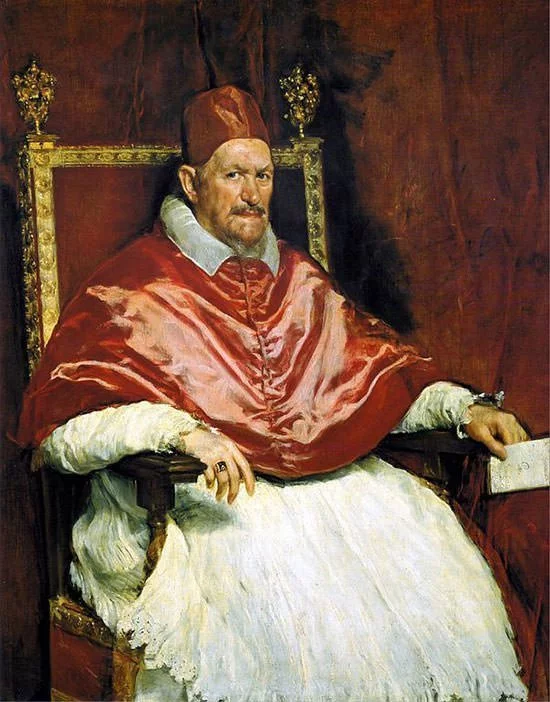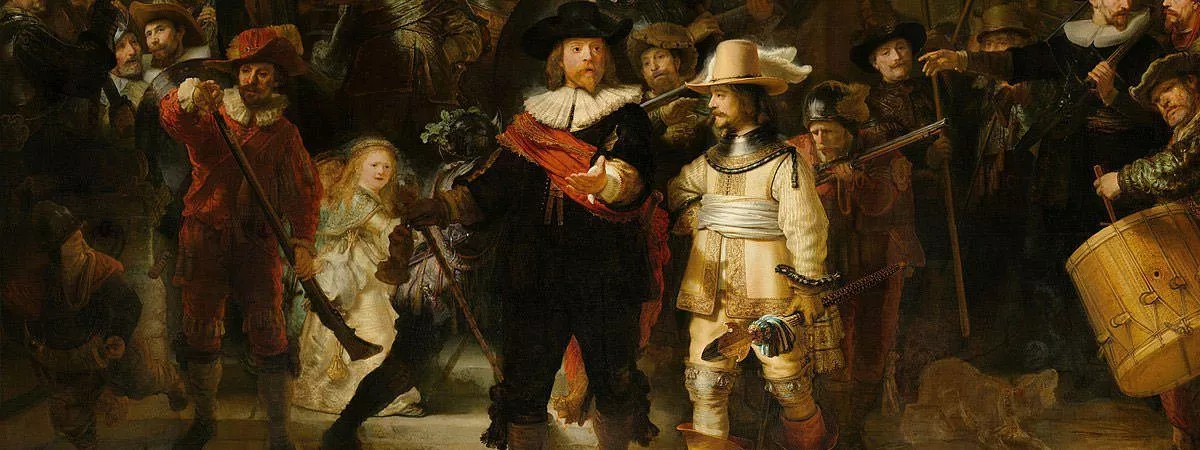The Baroque is a style of art that flourished in Europe from the early 17th century until the 1740s. The term Baroque comes directly from French (“a pearl of irregular shape”), which in turn comes from Portuguese barroco (“irregular pearl”); and is related to Spanish barrueco and Italian barocco. In painting, the Baroque style is characterized by great drama; rich color; intense light; and dark shadows. While Renaissance art is known for showing calm rationality, paintings in the Baroque period aimed to evoke emotion and passion. Baroque artists usually captured the most dramatic point; the moment when the action was occurring. An example of this may be seen in several of the most famous paintings of the period including The Return of the Prodigal Son by Rembrandt; Judith Slaying Holofernes by Artemisia Gentileschi; and Calling of St Matthew by Caravaggio. Here are the 10 most famous Baroque paintings.
#10 Judith Slaying Holofernes

| Location: | Museo Capodimonte, Naples, Italy |
| Artist: | Artemisia Gentileschi |
| Year: | 1620 |
Artemisia Gentileschi was an Italian Baroque artist who is today regarded as one of the most accomplished painters of her time as well as one of the greatest female artists of all time. Judith Slaying Holofernes is her most famous work. It is based on a story in the Old Testament. In the story, Holofernes is an Assyrian general who was about to destroy Bethulia, the home city of Judith. Judith, taking advantage of the Assyrian general’s desire for her, is able to enter his tent. After drinking excessively Holofernes passes out and Judith is able to decapitate him thus saving her city. One of the most famous depictions of the story, Gentileschi’s painting shows the moment when Judith, helped by her maidservant, beheads the general after he has fallen asleep drunk.
#9 Portrait of Innocent X

| Location: | Galleria Doria Pamphilj, Rome |
| Artist: | Diego Velazquez |
| Year: | 1650 |
During a trip to Italy, Velazquez offered to paint a portrait of the Pope who asked him to first prove his painting skills. Velazquez’s portrait of his servant Juan de Pareja convinced Pope Innocent X of his talent and this resulted in the creation of this famous masterpiece. The portrait shows such ruthlessness in Innocent’s expression that some feared it would displease the Pope but Innocent X was rather pleased and according to legend said, “Troppo vero!” (“all too true!”). Famous 20th century painter Francis Bacon painted a series of variants of this painting called the “Screaming Popes”, which are now famous in their own right. Portrait of Innocent X is considered by many art critics as the finest portrait ever created while Guardian calls it the most acute study of personal power in the history of art.
#8 Supper at Emmaus

| Location: | National Gallery, London |
| Artist: | Caravaggio |
| Year: | 1601 |
Caravaggio was an Italian artist whose paintings combine a realistic observation of the human state, both physical and emotional, with a dramatic use of lighting. He is regarded as one of the most influential artists in western art and his works had a formative influence on the Baroque school of painting. Due to this, he is known as the Father of Baroque painting. One of the most famous paintings created by Caravaggio, Supper at Emmaus, depicts the moment when the resurrected Jesus Christ first revealed himself to two of his disciples; most probably Luke and Cleopas; in the town of Emmaus. The painting in fact captures the exact moment when the two apostles realize that they are witnessing an unimaginable miracle. Christ has been shown without a beard and his flowing robes cover any indications of the wounds he suffered during the crucifixion.
#7 The Judgment of Paris

| Location: | National Gallery, London |
| Artist: | Peter Paul Rubens |
| Year: | 1639 |
According to Greek mythology, Eris, the Goddess of Discord, was prevented from attending the wedding of Peleus and Thetis. Being insulted like this, she threw her wedding gift from outside the door. This gift was a golden apple and had the engraving “To the fairest of them all”. The three goddesses Aphrodite, Hera and Athena all fought over this “Golden Apple of Discord”, each claiming to be the fairest and thereby the rightful recipient of the apple. Paris, the Trojan prince, was chosen by Zeus to make the decision. Sir Peter Paul Rubens, the most influential Flemish Baroque artist, created several versions of the Judgment of Paris and this version in the National Gallery is perhaps the most famous among them. The myth ends with Paris giving the Golden Apple to Aphrodite as she bribed him by promising him that he would marry the most beautiful mortal woman in the world. This made Hera begrudge Paris in a big way, which ended up affecting the outcome of the Trojan War.
#6 The Milkmaid

| Location: | Rijksmuseum, Amsterdam |
| Artist: | Johannes Vermeer |
| Year: | 1658 |
Johannes Vermeer was relatively obscure during his time but today he is regarded as the greatest painter of the Dutch Golden Age along with Rembrandt. This painting shows a milkmaid, a woman who milks cows and makes dairy products like butter and cheese. At the time the painting was created, the woman would have been actually known as a “kitchen maid” rather than a specialized “milkmaid”. Vermeer shows the woman to be young and sturdy. The painting is illusionistic. It depicts the scene not just with striking details but a sense of the weight of the woman and the table. The Milkmaid is one of the most famous paintings of not only Vermeer but of the entire Baroque Period. It is housed in Rijksmuseum in Amsterdam which regards it as “unquestionably one of the museum’s finest attractions”.
#5 The Return of the Prodigal Son

| Location: | Hermitage Museum, Saint Petersburg, Russia |
| Artist: | Rembrandt van Rijn |
| Year: | 1669 |
In the Parable of the Prodigal Son, a father has two sons; the younger of whom asks for his inheritance, wastes his fortune and returns home after becoming destitute. He intends to beg his father to make him one of his servants but the father, instead, celebrates his return. When his elder son objects, the father tells him that they are celebrating because his brother, who had been lost, has now come to his senses. Rembrandt’s painting depicts the moment when the son returns home in a wretched state. The father can be seen receiving his son with a tender gesture while the brother crosses his hands in judgment. Rembrandt is renowned for the exceptional realism in his paintings due to his trademark light and shadow effects. Painted at the end of his career, the artwork demonstrates his mastery as he uses expressive lighting and coloring to brilliantly evoke in the viewer the parable’s message of forgiveness. The Return of the Prodigal Son is regarded by many critics as Rembrandt’s greatest masterpiece and it is a monumental achievement in Baroque art.
#4 The Calling of St Matthew

| Location: | San Luigi dei Francesi, Rome |
| Artist: | Caravaggio |
| Year: | 1600 |
Saint Matthew was one of the twelve apostles of Jesus and, according to Christian tradition, one of the four Evangelists. Matthew was initially a tax collector and Jesus Christ found him sitting at the tax collector’s booth. “Follow me”, Jesus told him, and Matthew got up and followed him. This painting depicts the moment at which Jesus inspires Matthew to follow him. Caravaggio is one of the most influential artists in European art history. Among other things; he painted from life, without drawings; and developed a technique called tenebrism, which was marked by the use of violent contrasts of light and dark. This helped him to create paintings with high drama and emotional intensity. The Calling of St Matthew was an immediate sensation when it was first displayed and it remains one of the most famous works by the artist.
#3 The Night Watch

| Location: | Rijksmuseum, Amsterdam |
| Artist: | Rembrandt van Rijn |
| Year: | 1642 |
Rembrandt van Rijn is considered one of the greatest artists in history. The Night Watch was commissioned to him by Captain Frans Banninck Cocq and 17 members of his company of civil guards. Apt title of the painting would be The Company of Captain Frans Banning Cocq and Lieutenant Willem van Ruytenburch. However, due to the dark impression it makes on the viewer, it became known as The Night Watch. Comprising of 34 characters, the colossal masterpiece depicts the company, led by Cocq and Ruytenburch, moving towards the viewer. Its fame rests on several factors including its enormous size (11.91 ft × 14.34 ft); its coherent, dynamic and realistic portrayal; brilliant use of light and shadow by the artist; and Rembrandt’s mastery in making it appear to the viewer that the painting’s nearly human size figures are about to jump off the canvas and into real space. The Night Watch is one of the most renowned works in group portraiture and it is the most famous painting of not only Rembrandt but of the entire Dutch Golden Age.
#2 Girl with a Pearl Earring

| Location: | Mauritshuis, The Hague, Netherlands |
| Artist: | Johannes Vermeer |
| Year: | 1665 |
Girl with a Pearl Earring, the most renowned work of Johannes Vermeer, portrays a European girl wearing an exotic dress, an oriental turban, and a large pearl earring. Not much is known about the life of Jan Vermeer and nothing is known about the model who appears in the painting. Still, Girl with a Pearl Earring is one of the most famous portraits ever created and it is often called the “Mona Lisa of the North”. Perhaps the mystery surrounding the painting adds to its fame. In 1999, American novelist Tracy Chevalier wrote a historical novel with the same title as the portrait, fictionalizing the account of the creation of Vermeer’s masterpiece. It was later made into a film with the same title which was nominated for three Academy Awards.
#1 Las Meninas

| English Title: | The Maids of Honor |
| Location: | Museo del Prado, Madrid |
| Artist: | Diego Velazquez |
| Year: | 1656 |
Considered one of the most important paintings ever, Las Meninas depicts at its center the 5 year old Margarita Teresa. The infant Margarita is surrounded by her maids, bodyguard, two dwarfs and a dog. On the left, Velazquez depicts himself with a brush, leading to BBC calling this masterpiece “the world’s first photobomb”. Above the princess’ head is a mirror which shows her father and mother, King Philip IV of Spain and Mariana of Austria. They appear to be in position of the viewer. Velazquez perhaps depicts the scene of him painting the royal couple. Las Meninas has been described to represent the “theology of painting” and “the true philosophy of the art” by notable artists. Diego Velazquez is regarded as one of the most influential painters in European history and Las Meninas is considered his supreme achievement. It is one of the most analyzed paintings in Western art history and definitely the most famous painting of the Baroque Period.


Thank you so much!
You’re welcome.